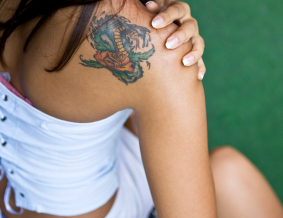 As the number of people with tattoos has risen, so has the number of people with second thoughts about those tattoos. If you need to undo a tattoo, you have two options: tattoo removal or alteration.
As the number of people with tattoos has risen, so has the number of people with second thoughts about those tattoos. If you need to undo a tattoo, you have two options: tattoo removal or alteration.
Most tattoo removal methods will get rid of all or most of the tattoo, but the results vary depending on the removal method you choose and the type of tattoo you have.
Laser Tattoo Removal
Lasers are considered the most effective method of tattoo removal. This is because the laser light actually breaks down the ink that is imbedded in the skin. The downside to lasers is that they are painful and don’t work well on some types or colors of ink. For example, a smaller-sized dark ink tattoo may be removable by laser, but a larger, more elaborate tattoo with many bright colors in it, may not diminish as well with laser removal. Laser tattoo removal can work on small or large tattoos, depending on the ink colors, but you will likely need many more sessions to remove a large tattoo.
Laser tattoo removal is also expensive: a single session could cost upwards of $250 and you could require several sessions to remove all the ink.
Laser tattoo removal has side effects, which can include:
- burning pain
- irritation
- loss of skin pigmentation, skin discoloration
Dermabrasion for Tattoo Removal
Dermabrasion is effective for some types of tattoos, but it is not considered as effective as laser removal. Tattoo ink is embedded beneath the top layer of your skin; dermabrasion rubs away that top layer to help release the ink underneath.
Dermabrasion is less expensive than laser removal, but could require several sessions to rub away all of the ink. Dermabrasion can remove any color of ink pigments, but the real issue is the depth of the ink--you might not be able to remove all of the ink if it is embedded too deeply in your skin.
Dermabrasion can also cause scarring, and loss of skin pigmentation. This means that once the ink is gone, you may have a “ghost” of the tattoo image in its place.
Dermabrasion works on small or large tattoos, but the larger the tattoo, the more sessions you will need.
Surgical Tattoo Removal
Surgery used to be the only way to remove a tattoo, but now it’s considered a last-ditch effort. This is because you actually have to cut the tattoo off your body then surgically close the incision. This approach is therefore best suited to very small tattoos.
Surgical removal is expensive, because you have to pay for the cost of the surgery as well as the anesthesia. Additionally, you will need more time to recover than with the other methods.
Surgery has a high risk of scarring and infection. If you have to surgically remove a larger tattoo, your doctor might need to graft skin from a donor, or from another area of your body.
Tattoo Modification
Tattoo modification is essentially changing an existing tattoo into something else. It could involve adding onto an existing tattoo, or painting over areas of it with new ink as a sort of camouflage. This may be an option for you if the other tattoo removal methods available wouldn't effectively remove your original tattoo.
The type of modification you choose will depend on the original tattoo. For example, tattoos with dark ink are harder to cover up (camouflage) and it may work better if they are embellished into a new design. Conversely, tattoos with very light colors could be successfully inked over.
Smaller tattoos are easier to modify than large ones. Also, a tattoo with a lot of empty space around it is easier to modify than one that is in close proximity to another tattoo. The exception would be if you want to incorporate both tattoos into a new blended design.
The cost for tattoo modification varies, depending on the size of the new tattoo, and how much ink the tattoo artist has to use in the modification. If it is an extensive design, you might need to sit for several sessions.
Modification doesn’t work well on large or extensive tattoos, like tattoos that form a sleeve over your arm, because the additional ink could make the image a dark, muddy mess.
If you have a small tattoo that can be incorporated into a new tattoo, and you don’t mind keeping your ink, you might be better off getting it modified than removing it. If you really want to get rid of the ink entirely, then you are better off going with laser removal or dermabrasion, and accepting the fact that removal may be painful, and may take several sessions before you see your tattoo ink diminish.

